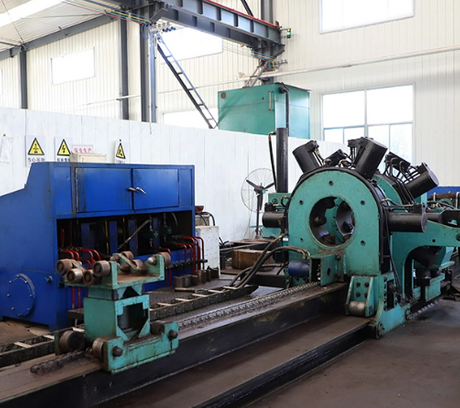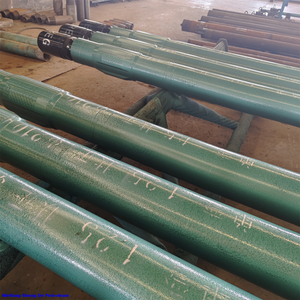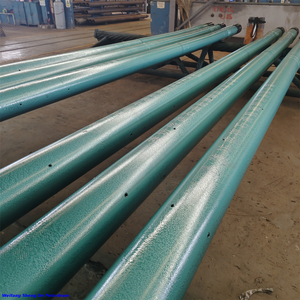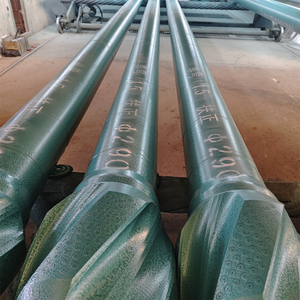You want to find the best drilling jar for your job. Start by thinking about your drilling conditions and what features matter most. The jar type and its strength should match your needs. If you focus on choosing a drilling jar that fits your project, you can avoid problems downhole. Shengde stands out as a trusted brand. Jar testing helps you check safety and reliability before you start drilling.
Tip: Always match your drilling jar with your equipment and environment for the best results.
Key Takeaways
Pick a drilling jar that fits your drilling needs. This helps you avoid problems deep in the well. Test your drilling jar often to make sure it is safe. This also checks if it works well before you drill. Always follow the maker's rules for taking care of your drilling jar. This helps it last longer and work better. Learn about the types of drilling jars like hydraulic, mechanical, and hybrid. This helps you choose the right one for your job. Buy good quality drilling jars for better results. This can save you money and help in tough places.
Key Factors in Choosing a Drilling Jar
When you pick a drilling jar, focus on what matters most. These things help you choose the right drilling jar for your work. They also help your drilling go well. Let's look at what you should check.
Application and Load Requirements
Every drilling job is unique. You must match your drilling jar to your well and the loads you expect. Vertical wells and horizontal wells need different things. Check this table to see how loads can change:
Drilling Type | Load Requirement | Jar Operation |
Vertical or Low-Angle Wells | Tension | Extended |
Highly Deviated Wells | Compression | Compressed |
If you drill a vertical well, you use the jar in tension. In horizontal or highly deviated wells, you use the jar in compression. This changes where you put the jar in your bottom hole assembly. Make sure your jar can handle the forces in your well.
Think about pressure, temperature, and drilling fluid too. Here are some things to remember:
Think about how deep your well is and what drilling fluid you use.
Look at the rocks you will drill through.
Check your jar often to keep it working well.
When you set the jar force and settings for your job, your drilling jar works better in hard places. This is very important when you need to free stuck pipe during fishing operations.
Reliability and Safety
Your drilling jar should work every time. Safety and reliability are both important. High-pressure, high-temperature wells need jars with strong seals and tough parts. The jar must work in hard conditions without breaking.
Note: The Bureau of Safety and Environmental Enforcement (BSEE) has new rules for high-pressure, high-temperature wells. These rules say you must use safety barriers and get outside reviews for your equipment plans.
The offshore industry also works with groups like the American Bureau of Shipping to make rules for these jobs. When you follow safety steps, you keep your team and tools safe.
Testing your jar is a big part of safety. Use testing tools and automated jar testers to check your jar before you use it. This helps you find problems early and avoid delays.
Manufacturer Guidelines
You want your drilling jar to last a long time. Manufacturer guidelines help you use your jar the right way. Here's what you should do:
Pick the right drilling jar for your job. Some jars work better for certain jobs.
Follow the instructions for use and care. This keeps your jar working well.
Store your jar the right way when you are not using it.
Check your jar often to find damage before it gets worse. When you do these things, your jar lasts longer and works better.
Tip: Always read the manufacturer's manual for when to check your jar and what testing tools to use. This helps keep your jar safe and working well.
Choosing a drilling jar is not just picking any tool. You want the best drilling jar for your job, your well, and your safety needs. When you care about quality and follow the right steps, you help your project succeed.
Types of Drilling Jars Explained
There are three main types of drilling jars. Each type works in its own way. Each one is good for certain drilling jobs. Let's look at how each type works. This will help you choose the right tool.
Hydraulic Drilling Jar
Hydraulic drilling jars use fluid pressure to work. You do not need to set a load first. This makes them simple to use. They work well in many drilling places. If you drill in high-angle or sideways wells, hydraulic jars are a good choice. They need only a little force to start.
Hydraulic jars do not need preset limits, so they work in many places.
Hydraulic jars act fast when you need them. They keep energy in the drillstring and let it go quickly. This gives a strong hit to help free stuck pipe. Many teams pick hydraulic jars because they are flexible.
Mechanical Drilling Jar
Mechanical drilling jars work in a different way. You must set a load before they work. This lets you control when the jar starts. If you want a tool that works only with a certain force, mechanical jars are best.
Mechanical drilling jars are not like hydraulic jars. They need a preset load before they work. They only react to force, not time.
Mechanical jars do not start by mistake very often. You can change the tension, but you must trip the drillstring to do it. These jars are good when you want exact control.
Hybrid and Specialty Jars
Hybrid jars mix features from hydraulic and mechanical jars. You get both control and flexibility. Hybrid jars work in many drilling places. You can use them for hard jobs.
Here is a table to help you compare drilling jars:
Type of Jar | How It Works | Good Points | Bad Points |
Hydraulic | Uses fluid pressure; no preset limit | Works in many wells; good for high angles | Less control; does not last as long |
Mechanical | Needs preset load | Easy to control; less chance of mistakes | Must trip to change; reacts to load |
Hybrid | Mixes hydraulic and mechanical features | Flexible; works in many places | More complex design |
If you want your drilling jar to work well, test it before you drill. Picking the right type helps you get the best results for your well.
Features of the Best Drilling Jar
Durability and Materials
You want your drilling jar to last a long time. The best jars use strong materials. These materials help stop wear and rust. If you work in tough places, you need a jar that can handle heat, pressure, and chemicals. 4145H alloy is a popular choice. It is very strong and tough. It lasts a long time. It does not crack or break easily, even after many hits.
Here's what makes a material strong and durable:
Material Type | Property | Description |
4145H Alloy | High Strength | Very strong after heat treatment. It keeps its shape well. |
| Wear Resistance | Hard and tough. It does not wear down fast. |
| Toughness | Can take many hits without cracking. |
| Durability | Works well in hot, high-pressure, and harsh places. |
Corrosion fatigue can cause problems. Tiny cracks can start where rust forms. These cracks grow when the jar is under stress. That is why you need a jar made from strong materials.
Activation Mechanisms
How your drilling jar works is important. Some jars use hydraulic systems. Others use mechanical parts. Each type gives you different control and speed. Some jars react fast. Others let you set the force. The best jar depends on your job and the type you need.
Tip: Always check how your jar works before you drill. Good testing with the right tools helps you avoid problems.
Ease of Maintenance
You want a drilling jar that is easy to take care of. Simple care means you spend less time fixing it. Look for jars with clear instructions. Make sure the parts are easy to reach. Good design makes cleaning and checking your jar quick. If you follow the care steps, your jar stays in good shape.
A good drilling jar saves you time and money. You get better results and fewer problems. Regular checks and good care keep your jar working well every time.
Matching Drilling Jar to Conditions
Downhole Environment
You face many challenges downhole. The rocks can be soft or very hard. The pressure and temperature change as you drill deeper. You need a drilling jar that works well in these tough places. If you drill in shale gas fields, you often deal with high pressure. Advanced hydraulic jars help you handle these conditions. They give you strong, controlled impacts. This makes fishing operations easier and faster. You also want a jar that keeps working even when the environment gets rough. Quality matters here. A jar with good quality will last longer and keep your team safe.
BHA Design and Compatibility
Your bottom hole assembly (BHA) is like a puzzle. Every piece must fit together. You place shock subs near the bit. You put the drilling jar higher up. This setup helps you get the best performance. You must check if your jar matches the other tools. Some jars work better with certain shock subs. You also need to think about the well's shape and the rocks you drill through. If you match the jar to your BHA and the drilling conditions, you avoid problems. Shengde's drilling jar stands out because it adapts to many BHA designs. It supports a wide range of environments, from soft to medium-hard strata. You get stable performance and fewer jerks or deviations. The quality of these jars helps you finish your job with less trouble.
Common Models and Applications
You see many types of drilling jars in the field. Hydraulic jars are popular in shale gas exploration. They handle high pressure and give you control. Some companies use smart jars that show real-time data. This helps you work faster and safer. Baker Hughes and Halliburton lead with ultra-high-strength jars. Transocean uses advanced hydraulic jars to cut drilling time by 20%. You want a jar that fits your job and your well. Jar testing helps you pick the right model. If you choose a jar with proven quality, you get better results in fishing operations and everyday drilling.
Here's a quick look at how Shengde compares to other brands:
Shengde
Feature | 's Products | Other Brands |
Adaptability | Wide range for soft to medium-hard strata | Varies by brand |
Stability | Maintains stable conditions, minimizes jerks and deviations | Often less stable |
Cost | Relatively low-cost | Generally higher |
Self-sharpening capability | Yes | Not always available |
You want quality, adaptability, and stable performance. Shengde gives you all three. If you match your drilling jar to your conditions and BHA, you set yourself up for success.
Cost vs. Quality in Choosing a Drilling Jar
Initial Cost vs. Long-Term Value
When you look for a drilling jar, you might notice the price first. High-quality jars cost more at the start, but they often save you money later. You get fewer breakdowns and less downtime. Lower-cost jars seem like a good deal, but they may wear out faster. Take a look at this table to compare prices:
Type of Drilling Jar | Price Range |
High-Quality Drilling Jars | $20,000 - $32,000 |
Lower-Cost Alternatives | Starting at $7,200 |
If you choose an efficient drilling jar, you spend less on repairs and replacements. You also get better results in tough drilling jobs. Jar testing helps you check if your jar will last and perform well.
Warranty and Support
You want to feel confident about your purchase. Good warranty and support make a big difference. When you buy a high-quality jar, you often get strong warranty coverage. You can call for help if something goes wrong. Some brands offer training and quick service. This support keeps your drilling project on track.
Tip: Always ask about warranty length and what it covers before you buy. Good support means less stress for you.
Balancing Budget and Performance
You need to balance your budget with the performance you expect. If you pick the cheapest option, you might face more problems downhole. High-quality jars work better in harsh conditions. They last longer and help you avoid costly delays. You should think about the total cost, not just the price tag. Quality matters more than saving a few dollars. When you choose a jar with proven quality, you set yourself up for success.
Make a list of what you need from your jar.
Compare the features and support each brand offers.
Choose the jar that gives you the best value for your money.
Remember: Quality tools help you finish your job faster and safer. You get peace of mind and better results.
Drilling Jar Tester and Maintenance
Importance of Testing
You want your drilling jar to work every time you use it. Jar testing helps you spot problems before you start drilling. A drilling jar tester checks if your jar is ready for action. You can use automated jar testers or manual jar testers, depending on your setup. Testing equipment makes sure your jar works as it should. When you test your jar, you lower the risk of accidents and keep your team safe.
Here's why testing matters:
You find issues with your jar before you put it in the well, so you avoid surprises.
Regular testing keeps your jar reliable and helps you save money on repairs.
Testing boosts safety and makes your drilling job run smoother.
Safety precautions are important during testing. Always follow the steps from your manufacturer. If you skip testing, you might face breakdowns or delays. Testing gives you peace of mind and helps you plan your work better.
Maintenance Best Practices
Taking care of your drilling jar is just as important as testing. You need to check your jar often and fix any problems right away. Continuous use can wear down your jar, so regular inspections help you catch damage early. If you ignore maintenance, your jar might break down when you need it most.
Here are some tips for keeping your jar in top shape:
Inspect your jar after each job and look for signs of wear.
Upgrade parts when needed to keep your jar working well.
Clean your jar and store it properly to prevent rust and damage.
Shengde gives you clear maintenance guidelines. Follow these steps to keep your jar strong and reliable. Good care means fewer breakdowns and safer drilling. When you stick to a maintenance routine, your jar lasts longer and performs better.
Conclusion
When you pick the right drilling jar, your project goes better. The best drilling jar matches your well and your team. It also fits your goals for the job. You get better results if you use a drilling jar tester before each run. Here is what people in the industry have learned:
Placing the jar in the right spot stops it from getting stuck.
Studying the ground helps you stay away from problem areas.
Using all these steps together makes the wellbore better.
Evidence Description | Impact on Drilling Efficiency |
Finds problems early, before they stop your work | Helps you avoid expensive delays in drilling or fishing |
New technology makes jar testing easier and more exact | Needed for today's drilling, so you have less downtime |
You can count on a trusted brand like Shengde for good products and help. If you want the best outcome, talk to experts or the company about what you need.
FAQ
What is the main job of a drilling jar?
You use a drilling jar to free stuck drill strings downhole. It delivers a strong, controlled impact when you need it most. This tool helps you keep your drilling project moving forward.
How do I know which drilling jar fits my well?
You should match the jar to your well's depth, pressure, and rock type. Check your bottom hole assembly design. If you feel unsure, ask your manufacturer or a drilling expert for advice.
How often should I test or maintain my drilling jar?
You need to test your drilling jar before each run. Inspect it after every job. Regular checks help you spot wear or damage early. This keeps your jar safe and ready for action.
Tip: Always follow the maintenance steps from your manufacturer for the best results.



















